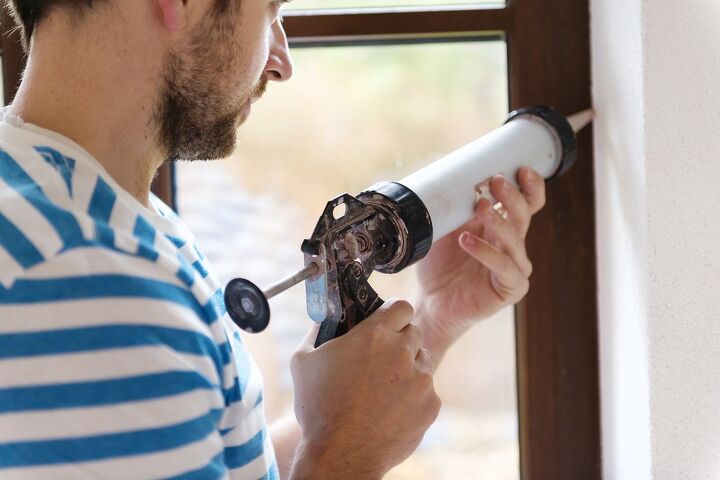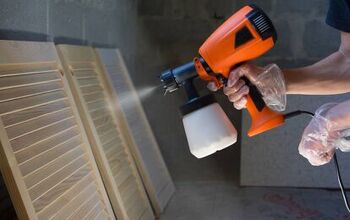How To Paint Over Non-Paintable Caulk (Quickly & Easily!)

Caulk is one of the most versatile tools that you can have, especially when you are putting together a bathroom. We all know that there are two main types of caulk used in remodels: paintable and non-paintable caulk. If you need to use non-paintable caulk, this can pose a problem when it comes to the issue of paint. After all, you want to paint stuff, right? So, how do you paint over non-paintable caulk?
Technically, there are two main ways to paint over non-paintable caulk without actually removing the caulk. The most common way to fix this is to cover the caulk with paintable caulk, then paint it. However, anecdotal evidence suggests that caulk with a primer and using a high-coverage paint will work too.
Most of the time, it’s best to assume that non-paintable caulk shouldn’t be painted on directly. It usually doesn’t end up well, and the truth is, it takes some strategy to make this paint work. This guide can help you figure out what you should do.
Do You Need to Hire a Paint Contractor?
Get free, zero-commitment quotes from pro contractors near you.

Before You Begin: A Quick Heads Up
If you have tried to paint over non-paintable caulk before, you already should know that it tends to crack and fall away. It’s not a good look, and in most cases, it’s best to stick with paintable caulk when you have a project that you want to make look perfect. That’s why most people who need to paint over non-paintable caulk choose to scrape it away and replace it with paintable caulk.
Honestly, if you don’t mind the extra work, replacing your caulk with a paintable type is the best way to go. It may take longer, but it will have the most seamless look. That’s why most people choose to just strip the caulk and assume that non-paintable means you shouldn’t take paint to it at all.
What Happens If You Paint Non-Paintable Caulk?
This is a bit of a loaded question, since there are a huge number of different paints that you could attempt to use. This means that you will see an awkward thing happen. Sometimes, the paint won’t dry regardless of how long you wait. Other times, it’ll dry but will flake off or look weird. Either way, it’s going to look bad if you try to apply paint directly on the caulk.
When Would This Be Necessary?
Most of the time, painting non-paintable caulk will not be necessary. However, you might eventually have a bathroom or shower setup that would look just a little bit better with a seamless, painted look.
How To Paint Over Non-Paintable Caulk (And Still Get Good Results)
Now that we’ve gotten the major caveat out of the way, it’s important to discuss the two most common ways people paint over non-paintable caulk. Let’s check them out by each major method, and then take a look at some factors that can help you figure out whether painting is really a good idea.
Adding A Layer Of Paintable Caulk
So, this is actually fairly straightforward. It also happens to be the best way to get good results. To do this, you will need to grab some paintable caulk and apply a thin layer over the caulk that’s already there. Let it dry, then go for a type of paint that will work well with caulk. )(Oil-based paints are best for this, just in case you know.)
While this is fairly straightforward, it’s best to follow these smart tips below:
- Make sure to remove excess caulk from your area before you start painting, or even start adding an extra layer. Most of the time, people who use caulk tend to have a couple of extra drops in and around the area. Use a knife or a razor blade to trim away any excess bubbles or drops. It’ll make things smoother.
- Use a piece of paper or a similar tool to even out the caulk before it dries. Paint will show nicks and dips quicker than you think. And, it will make your entire painting experience rougher. So, make sure that it’s a smooth surface before you let it dry. You can and will thank yourself later.
- When you do finally end up painting your caulked area, make sure to use paint that’s suggested for caulking. Most paintable caulks will have instructions that describe the best paints to use on their surfaces. If you aren’t sure, most oil-based paints tend to do best. (Besides, they’re water-resistant!)
Priming And Painting Non-Paintable Caulk
Before we start talking about the way to do this, I’m going to have to put a major warning label. This is a method that we’ve seen being promoted on online forums, and so far, the results have been mixed at best. We do not suggest this, but it’s still a potential option if you want to give it a try. Just saying. You’ve been warned.
- First, start by adding a primer to the non-paintable caulk. The primer that we saw mentioned is Rustoleum’s Ultra Cover Paint and Primer. Ultra Cover Primer also tends to be popular. However, you can use a similar paint primer from another company.
- After that, wait for the caulk’s primer to dry. Take a look to see how the primer took to the caulk. Some non-paintable caulks will work well with primer, others won’t. If yours works well, proceed to the next step. Otherwise, wipe the primer off and try to work with the first method listed in this article.
- Prep the area for the spray paint you want to use. We suggest using spray paint from the same series as the primer. Most of the time, oil-based paints will work best. However, we strongly suggest reading the can of primer before you pick out a paint.
Important Things To Consider Before You Paint Caulk
At the end of the day, most people want to make their home renovations look as crisp and seamless as possible. It’s an admirable effort. But, there are still things to consider before you start painting your gear. Here are some tips to help you figure out which is best for you:
- Patterned surfaces are best left unpainted. While it might seem like a sleek idea to paint the caulk to match one surface or another, in many cases, it doesn’t work. The lack of a pattern is often too noticeable to ignore.
- If you are unsure of the shade you should use, consider getting multiple paint swatches to figure things out. Even then, it may not be the perfect match. That’s why it may be better to choose some clear caulk or to leave it be.
- Black on black surfaces may be better treated through the use of black or otherwise tinted caulk. Yes, it’s true. You can get black silicone caulk at most major hardware stores. In fact, you also might be able to get certain other colors, too. It’s worth a shot and will reduce the amount of painting or scraping you’ll have to do.
- When all else fails, remember that clear caulk never looks that bad. Is it ideal? In some cases, yes. In others, not quite. However, no one is ever going to judge you for using clear caulk. It has the most seamless look out of all silicone sealants.
Do You Need to Hire a Paint Contractor?
Get free, zero-commitment quotes from pro contractors near you.

Related Questions
Does silicone caulk stick to paint?
While silicone (non-paintable) caulk doesn’t do well with paint that’s added on top of it, the truth is that the caulk itself can stick fairly well to surfaces that have been painted. So while you can add it to a painted surface without an issue, it’s best not to try to paint on top of it. Because non-paintable caulk is 100 percent silicone, there is not much you can do to make anything stick to it. It’s totally waterproof, oilproof, and everything-proof.
Can you remove caulk with water?
By its very nature, caulk is designed to be waterproof. Once the caulk has dried and cured, there is little to no chance of getting it off using something as simple as water. However, if the caulk hasn’t dried yet, it’s possible to wipe it away using copious amounts of water. With that said, most people prefer to pull or scrape it away instead.Due to the fact that caulk is primarily made of silicone, there isn’t a chemically-based way to remove caulk that has dried on site. You will need to manually remove it in order to get it off your project.
What is the best type of caulk for painting?
The most obvious, generic answer would be to say paintable caulk. However, there are several different types you can choose from. The most popular and versatile of the bunch is acrylic caulk, also known as latex caulk.Acrylic caulk is made of both acrylic and latex. While this is great for projects that need to be painted, it’s important to remember that this type of caulk is NOT moisture-proof. As a result, it shouldn’t be used in bathrooms or outdoor settings. The caulk may end up dissolving if you do.

Ossiana Tepfenhart is an expert writer, focusing on interior design and general home tips. Writing is her life, and it's what she does best. Her interests include art and real estate investments.
More by Ossiana Tepfenhart



























